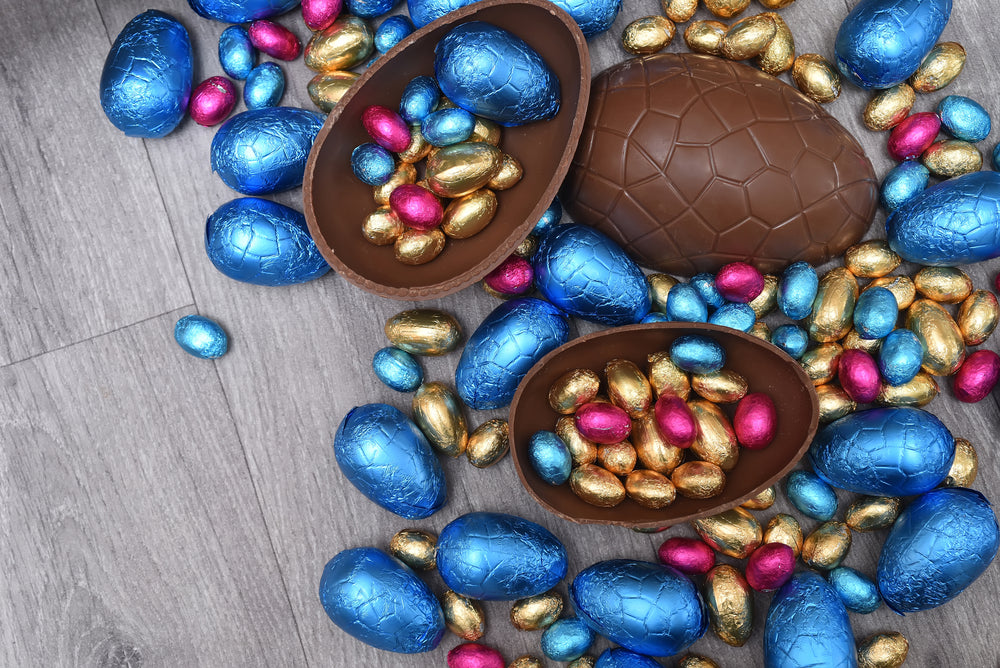We know of Easter Eggs to be chocolate shaped in the form of an egg or hollow chocolate shells that are stuffed with even more little treats. However, there is a history of several centuries over which the story of how Easter Eggs came to be. Ever since Christians have been celebrating the resurrection of Jesus, they have been celebrating Easter, and along with it, they have made certain traditions that have been followed for years – these traditions may have been changed a bit, but at its core, it continues to hold the same meaning with which it was created, centuries back.
History of the Easter Eggs

Easter is an important day for Christians as they honour the crucifixion and resurrection of Jesus Christ. It is celebrated in a beautiful way by going to church, preparing delicious foods, and having family gatherings; exchanging Easter Eggs is also an important part of this celebration.
Traditionally, at spring festivals, people exchanged eggs as a way of welcoming the new season. It is believed that eggs, which stand for rebirth and fresh life, influenced Easter celebrations from an old tradition.
During Lent, which is the 40 days leading up to Easter, eggs were not allowed to be eaten in the medieval era, so enjoying an egg on Easter Sunday was truly a pleasure, especially for the poor who couldn't afford to buy meat. On Good Friday, eggs were given as offerings, and villagers also presented eggs to the lord of the manor on Easter. Soon, even the royals began to participate in this tradition, and in 1290, Edward I bought 450 eggs, which he then decorated with gold leaves or colors and distributed to his household.
By the 19th century, the tradition of Easter eggs had become firmly established in British culture. Decorated eggs made from materials such as wood, cardboard and papier-mâché were exchanged as gifts. They were often filled with sweets or small toys for children. The Victorians also popularized the practice of elaborate egg-shaped ornaments that were made from porcelain or metal, which were displayed as decorations during the Easter season.
Pace Eggs and Egg Roll
During the medieval times in Northern England, the tradition of Pace eggs was quite popular. Pace eggs are also known as Pasche eggs or Peace eggs and are a traditional Easter custom in parts of northern England, particularly in Lancashire, Yorkshire and Cumbria. The term "Pace" is derived from the Latin word "Pascha," meaning Easter.
Pace eggs are hard-boiled eggs that are dyed and decorated using natural materials such as onion skins, leaves and flowers. The eggs are often wrapped in stockings or muslin cloth before being boiled, which creates a mottled or patterned effect on the eggshell. Common natural dyes used include onion skins for shades of brown and yellow, while other plants and vegetables may be used to create different colours.
The decorated eggs are then traditionally rolled down hills as part of Easter Monday celebrations, with the rolling symbolizing the rolling away of the stone from the tomb of Jesus Christ during the resurrection. In some areas, pace egg rolling competitions are held, where participants compete to see whose egg can roll the farthest without breaking.
Pace eggs are a tradition in northern England, celebrated as part of Easter festivities, and provide a fun and joyful activity for families and communities to enjoy together.
Modern Day Easter Eggs

Back in the days when Christians used actual eggs (ducks, hens, or geese) for Easter, they were now available in the form of chocolaty treats.
Fry's became the first company to sell a chocolate egg for Easter in the year 1873. Cadbury followed their footsteps and launched their own section of chocolate eggs in 1875. The company used dark chocolate to make Easter Eggs – they were just plain smooth chocolate. However, in 1897, Cadbury introduced their Dairy Milk Chocolate, and using this same recipe, they made their Easter Eggs too. It instantly became one of their bestsellers as people loved this recipe. A variety of Easter eggs were now available in various recipes, including dark chocolate, milk chocolate, and even white chocolate.
Famous Varieties of Easter Eggs in Britain

Here are some famous varieties of Easter Eggs available in Britain –
Cadbury Creme Egg – This is the most famous Easter egg available in Britain. The Cadbury Creme Egg is a milk chocolate egg filled with a sweet fondant filling designed to resemble the yolk and white of a real egg.
Cadbury Mini Eggs – These small, pastel-coloured chocolate eggs are a favourite Easter treat. These are crispy candy shells surrounding smooth milk chocolate.
Lindt Lindor Eggs – Lindt's famous Lindor truffles are also available in egg form during the Easter season, with a milk chocolate shell filled with smooth chocolate truffle filling.
Ferrero Rocher Eggs – Ferrero Rocher's luxurious chocolate eggs are a delicious Easter indulgence. It has a creamy hazelnut filling encased in a rich milk chocolate shell.
Thornton's Continental Eggs – Thornton's also offers a range of premium Easter eggs inspired by their Continental chocolate collection.
Hotel Chocolat Eggs – Known for their high-quality chocolates, Hotel Chocolat offers a selection of indulgent Easter eggs made from luxury chocolate that are filled with gourmet treats such as truffles, pralines and caramel-filled chocolates.
Green & Black's Organic Eggs – Green & Black's offers organic and Fairtrade-certified Easter eggs made from high-quality chocolate. The brand makes sure to use sustainable and ethically sourced ingredients.
Some Superstitions About Easter Eggs

When there is tradition, there is bound to be some type of superstition! During Easter too, there were also a lot of superstitions regarding eggs. It was thought that eggs laid on Good Friday if preserved for about 100 years, would change into diamonds. It was also thought if someone found two yolks in an egg, they would get wealthy. People began to have their eggs blessed before eating them because of the belief that cooking eggs on Good Friday and eating them on Easter Sunday would increase fertility and avoid unexpected death.


 Easter 2026
Easter 2026
 Frozen Food
Frozen Food
 Baking
Baking
 Beans, Peas, Soups & Tins
Beans, Peas, Soups & Tins
 Biscuits, Crackers & Cookies
Biscuits, Crackers & Cookies
 Candy / Sweets
Candy / Sweets
 Crisps & Snacks
Crisps & Snacks
 Chemist / Pharmacy
Chemist / Pharmacy
 Desserts
Desserts
 Gravy, Stock & Paste
Gravy, Stock & Paste
 Haggis
Haggis
 Indian Sauces, Paste and Pickle
Indian Sauces, Paste and Pickle
 Jams & Preserves
Jams & Preserves
 Poppy Appeal
Poppy Appeal
 Pot Noodles & Super Noodles
Pot Noodles & Super Noodles
 Scone Mix
Scone Mix
 Gluten-Free / Free From
Gluten-Free / Free From
 Tea Accessories
Tea Accessories
 Teapot & Tea sets
Teapot & Tea sets
 Tea For One
Tea For One
 Sugar & Creamer
Sugar & Creamer
 Tableware
Tableware
 Serveware
Serveware
 Plates & Trays
Plates & Trays
 Bowls
Bowls
 Cups & Saucers
Cups & Saucers
 Mugs
Mugs
 Silverware
Silverware
 Dinnerware - Accessories
Dinnerware - Accessories
 Dinnerware - For Pets
Dinnerware - For Pets
 Victoria Eggs - Hand-Drawn UK Homeware
Victoria Eggs - Hand-Drawn UK Homeware
 Jewelry & Accessories
Jewelry & Accessories
 Sale
Sale
 Christmas Gifts
Christmas Gifts

